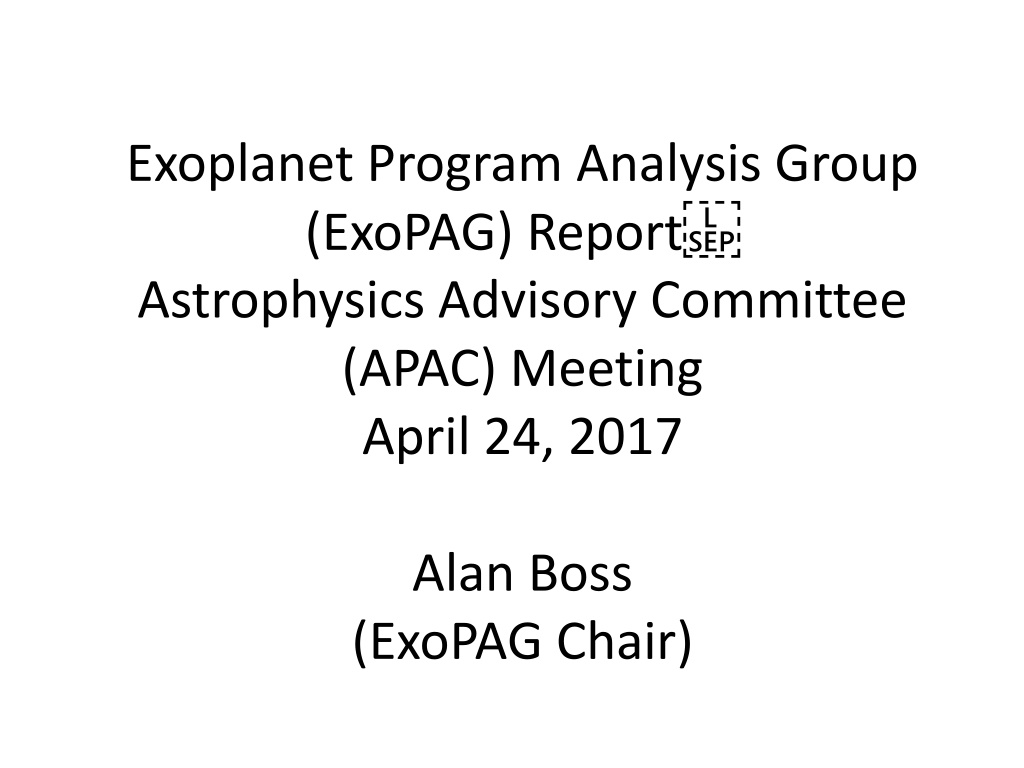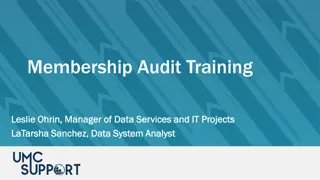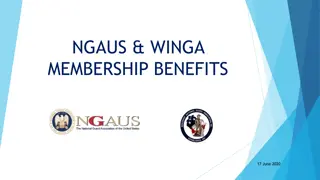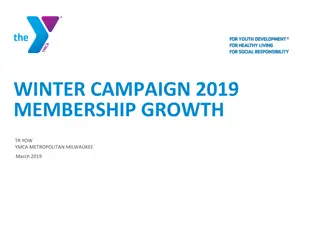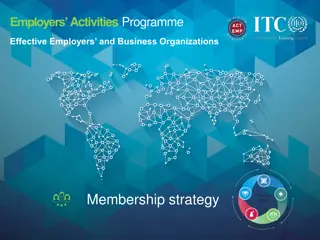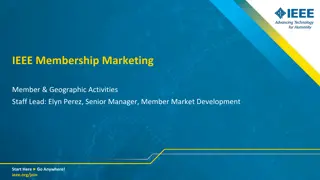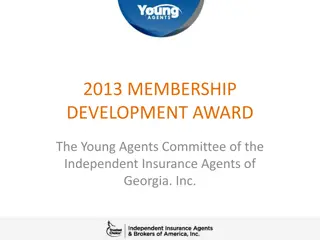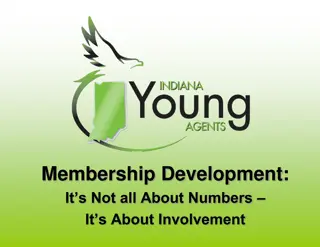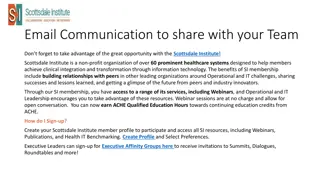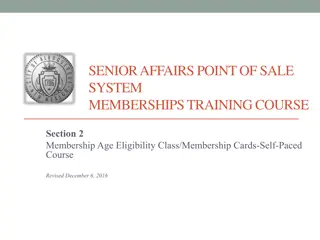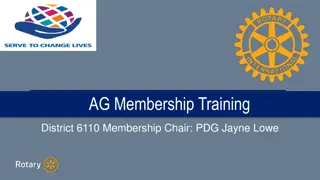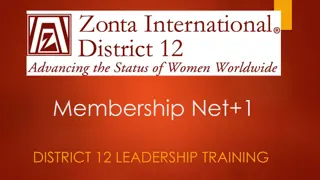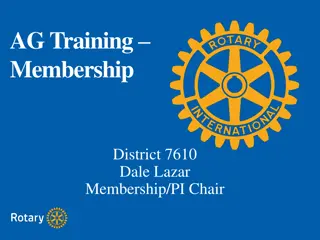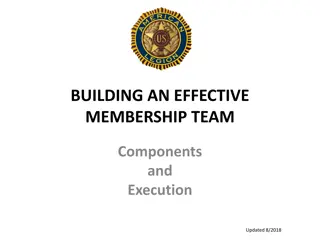ExoPAG Analysis Groups and Membership Changes
The report discusses the analysis groups and membership changes within the Exoplanet Program Analysis Group (ExoPAG) and highlights the losses and additions in the ExoPAG Executive Committee (EC) membership. It also outlines the completed and active study analysis groups focusing on various aspects of exoplanet research and mission requirements. The document provides valuable insights into the evolving landscape of exoplanet science and research collaborations.
Download Presentation

Please find below an Image/Link to download the presentation.
The content on the website is provided AS IS for your information and personal use only. It may not be sold, licensed, or shared on other websites without obtaining consent from the author.If you encounter any issues during the download, it is possible that the publisher has removed the file from their server.
You are allowed to download the files provided on this website for personal or commercial use, subject to the condition that they are used lawfully. All files are the property of their respective owners.
The content on the website is provided AS IS for your information and personal use only. It may not be sold, licensed, or shared on other websites without obtaining consent from the author.
E N D
Presentation Transcript
Exoplanet Program Analysis Group (ExoPAG) Report Astrophysics Advisory Committee (APAC) Meeting April 24, 2017 Alan Boss (ExoPAG Chair)
ExoPAG EC Membership Losses Alan Boss (Chair) Carnegie Institution Daniel Apai Rus Belikov David Ciardi NASA Exoplanet Science Institute Shawn Domagal-Goldman NASA Goddard Space Flight Center Tiffany Glassman Northrup Grumman Aerospace Sys. Dimitri Mawet Tyler Robinson University of California, Santa Cruz Maggie Turnbull Global Science Institute Lucianne Walkowicz Scott Gaudi (Past Chair, Ex officio) Ohio State University Martin Still (Ex officio) NASA Headquarters University of Arizona NASA Ames Research Center Jet Propulsion Laboratory Adler Planetarium
New ExoPAG EC Membership Alan Boss (Chair) Carnegie Institution Daniel Apai David Ciardi NASA Exoplanet Science Institute Shawn Domagal-Goldman NASA Goddard Space Flight Center Tiffany Glassman Northrup Grumman Aerospace Sys. Eliza Kempton Grinnell College Dimitri Mawet Michael Meyer University of Michigan Tyler Robinson University of California, Santa Cruz Chris Stark Space Telescope Science Institute Johanna Teske Scott Gaudi (Past Chair, Ex officio) Ohio State University Martin Still (Ex officio) NASA Headquarters University of Arizona Jet Propulsion Laboratory Carnegie Observatories
Completed Study Analysis Groups (SAGs) Year SAG Title Lead 2010 1 Potential for Exoplanet Science Measurements from Solar System Probes Bennett, Coulter 2012 2 Debris Disks & Exozodiacal Dust Roberge 2013 5 Exoplanet Flagship Requirements and Characteristics Noecker, Greene 2015 8 Requirements and Limits of Future Precision Radial Velocity Measurements Latham, Plavchan 2015 9 Exoplanet Probe to Medium Scale Direct-Imaging Mission Requirements and Characteristics Soummer 2015 10 Characterizing the Atmospheres of Transiting Planets with JWST and Beyond Cowan 2014 11 Preparing for the WFIRST Microlensing Survey Yee 2017 12 Scientific potential and feasibility of high-precision astrometry for exoplanet detection and characterization (final presentation at ExoPAG #15, January 2017) Bendek 3,4,6,7 [SAG numbers not used]
Active Study Analysis Groups (SAGs) Year SAG Title Lead -- 13 Exoplanet Occurrence Rates and Distributions (planned completion June 2017) Belikov -- 14 Characterization of Stars Targeted for NASA Exoplanet Missions (on hold) Stassun -- 15 Exploring Other Worlds: Observational Constraints and Science Questions for Direct Imaging Exoplanet Missions (draft report expected soon) Apai -- 16 Exoplanet Biosignatures (final report by August 2017?) Domagal- Goldman -- 17 Community Resources Needed for K2 and TESS Planetary Candidate Confirmation (final report by June 2017?) Ciardi & Pepper -- 18 Metrics for Direct-Imaging with Starshades (ready to write final report) Glassman & Turnbull -- 19 Exoplanet imaging signal detection theory and rigorous contrast metrics (in progress) Mawet & Jensen- Clem
ExoPAG Study Analysis Groups (SAGs) Overall Status 8 SAGs finished work (7 with final report online) Accept SAG 12 (exoplanet astrometry) close-out? 7 SAGs actively working 3 SAGs nearing completion in mid 2017: SAG 13 on exoplanet demographics (Belikov) SAG 16 on exoplanet biosignatures (Domagal- Goldman et al.) SAG 17 on transit confirmations (Ciardi & Pepper)
Technology Needs and Prioritization Process ID Activity Date 1 Technology Needs Input Window Opens 06/08/16 email all three PAGs: Technology Gap Lists, Input Forms, process explanation presentation at June ExoPAG 06/12/16 2 Technology Window Closes 08/26/16 3 Technology Gap Selection and Prioritization Criteria Peer Review 09/08/16 Selection and Prioritization Criteria Review by Independent Review Board convened by ExoTAC 09/21/16 4 Technology Gaps Assessed and Prioritized by the ExEP 10/10/16 Technology Gap Assessment and Prioritization Reviewed by Independent Review Board convened by ExoTAC 10/20/16 5 Technology Gap Lists Inform TDEM Amendment mid-Nov Technology Amendment released through NSPIRES mid-Dec 6 ExEP Technology Plan Appendix Updated and Posted 12/22/16 Presentation at January ExoPAG 01/02/17 7 TDEM Proposal Deadline 03/17/17 8 TDEM Awards Selected Aug 2017
Technology Needs and Prioritization Process ID Activity Date 1 Technology Needs Input Window Opens ? email all three PAGs: Technology Gap Lists, Input Forms, process explanation presentation at June ExoPAG #16, prior to KepSciCon at NASA Ames 06/18/17 2 Technology Window Closes ? 3 Technology Gap Selection and Prioritization Criteria Peer Review ? Selection and Prioritization Criteria Review by Independent Review Board convened by ExoTAC ? 4 Technology Gaps Assessed and Prioritized by the ExEP ? Technology Gap Assessment and Prioritization Reviewed by Independent Review Board convened by ExoTAC ? 5 Technology Gap Lists Inform TDEM Amendment ? Technology Amendment released through NSPIRES ? 6 ExEP Technology Plan Appendix Updated and Posted ? Presentation at January ExoPAG ? 7 TDEM Proposal Deadline ? 8 TDEM Awards Selected ?
ExoPAG Future Activities Continue monthly ExoPAG EC telecons Continue work of seven active SAGs 13, 14, 15, 16, 17, 18, and 19 Review ExEP Technology Gap List planning Hold ExoPAG #16 meeting prior to KepSciCon in Mountain View, CA on June 18, 2017 Hold ExEP splinter sessions to send and receive at AbSciCon (Mesa, AZ), AAS (Austin, TX), and during KepSciCon (NASA Ames, Moffett Field, CA)
APAC Action Requested by ExoPAG EC Accept close-out of SAG 12 - Scientific Potential and Feasibility of High-Precision Astrometry for Exoplanet Detection and Characterization (Eduardo Bendek, Chair)? Final close-out presentation (at ExoPAG #15, January 2017) was circulated to the APAC prior to this meeting
SAG 12: Scientific Potential and Feasibility of High- Precision Astrometry for Exoplanet Detection and Characterization (Eduardo Bendek, Chair) Key questions and goals that this group will address are: 1) What is the scientific potential of astrometry for different precision levels? Which planet types, confirm planet candidates. 2) What are the technical limitations to achieving astrometry of a given precision? Technical challenges, observational strategies or post processing to improve the astrometry. 3) Identify mission concepts that are well suited for astrometry. Next mission after GAIA that will make exoplanet science possible? What are the requirements for such a mission? 4) Study potential synergies with current and future European astrometry missions. What are the available astrometric facilities to follow-up on GAIA (exoplanet-related) discoveries? Are they sufficient?
SAG 13: Exoplanet Occurrence Rates and Distributions (Rus Belikov, Chair) Key objectives and questions: 1. Propose standard nominal conventions, definitions, and units for occurrence rates/ distributions to facilitate comparisons between different studies. 2. Do occurrence estimates from different teams/methods agree with each other to within statistical uncertainty? If not, why? 3. For occurrence rates where extrapolation is still necessary, what values should the community adopt as standard conventions for mission yield estimates? Recent Progress: Computation/crowdsourcing of eta tables 11 participants submitted tables so far Latest estimates of occurrences of potentially habitable planets seem to be converging (at least to a factor of ~2-3), and explanations for discrepancies are starting to clarify Expected product in mid 2017: estimates of occurrence rates
SAG 14: Characterization of Stars Targeted for NASA Exoplanet Missions (Keivan Stassun, Chair, and TESS coI for Target Selection ) [TESS = Transiting Exoplanet Survey Satellite] SAG 14 has prepared a preliminary analysis of potential benefits of a pre-launch spectroscopic survey of TESS targets: Primary TESS goal: discover 50 Earth-sized transiting planets (R < 4 REarth) whose masses can be measured by follow-up radial-velocity measurements. Analysis of activity-driven RV jitter in TESS targets shows that, even in most stringent worst-case scenario, TESS is certain to deliver the above mission science requirement. A pre-launch spectroscopic survey of TESS targets could help ensure an even larger yield on the above goal by identifying an even larger sample of low-activity, Doppler stable target stars. SAG 14 report is on hold.
SAG 15: Exploring Other Worlds: Observational Constraints and Science Questions for Direct Imaging Exoplanet Missions (Daniel Apai, Chair) Charge: 1) What are the most important science questions in exoplanet characterization, apart from biosignature searches? What type of data (spectra, polarization, photometry), with what quality (resolution, signal-to-noise, cadence), is required to answer these science questions? 2) Progress: SAG15 underway and on track Team, timeline, process, milestones identified Up-to-date status and documents: eos-nexus.org/SAG15/ Currently finishing work on list of high-level science questions Target date for completion Spring 2017 Report + refereed publication are foreseen Interactions with WFIRST and Large Mission STDTs important
SAG 16: Biosignatures (Shawn DomagalGoldman, Nancy Kiang, and Niki Parenteau, Co-Chairs) Science Goals We seek to answer 3 broad questions: 1) What are known remotelyobservable biosignatures, the processes that produce them, and their known nonbiological sources? 2) How can we identify additional biosignatures, and a more comprehensive framework for biosignature assessment? 3) What are the requirements for detecting these biosignatures to different levels of confidence? A 3-day workshop was held on July 27-29, 2016, along with the NASA Astrobiology Institute (NAI) and the Nexus for Exoplanet System Science (NExSS). Plan is to draft a SAG report and a peer- reviewable paper by mid 2017, invite review and commentary from the community, and submit final SAG report by end of 2017.
SAG 17 Community Resources Needed for K2 and TESS Planetary Candidate Confirmation (David Ciardi and Joshua Pepper, Co-Chairs) SAG 17 will study and enumerate the resources needed by the community to effectively and efficiently validate as many K2 and TESS candidates as possible, and propose methods to allow the community to coordinate and self organize the process. Specific goals of SAG 17 include the following: Identify needed follow up observations for K2 and TESS including but not limited to imaging, spectroscopy, and time series follow up Identify telescopes, instrument, and financial resources available to the US community Identify how archival resources can be utilized (e.g., Gaia) Identify how the community can be organized and communication facilitated particularly with regards TESS full frame images, candidate identification, single transiting events, and candidate prioritization. Identify needs to ensure efficient and effective characterization with JWST (and WFIRST) Identify connections to other SAG efforts (e.g., SAGs 15 and 16)
SAG 18 Metrics for Direct-Imaging with Starshades (Tiffany Glassman and Maggie Turnbull, Co-Chairs) We propose to identify the areas of starshade performance where standardized metrics would be beneficial, and to create rigorous definitions of key terms, data processing techniques, and performance requirements. There have been informal definitions of contrast as the amount of residual starlight at the location of an exoplanet of interest and of suppression as the total amount of residual starlight entering the telescope. How can contrast or suppression be used as metrics of starshade performance (pros and cons)? How should contrast be defined? How should suppression be defined? What contrast limit is required to detect a planet of a given magnitude at the inner working angle (IWA)?
SAG 19 Exoplanet Imaging Signal Detection Theory and Rigorous Contrast Metrics (Dimitri Mawet and Rebecca Jensen-Clem, Co-Chairs) Go back to the basics of Bayesian Signal Detection Theory (SDT), i.e., H0:signal absent / H1:signal present hypothesis testing. Rebuild a solid set of usual definitions used for or in lieu of contrast in different contexts, such as astrophysical contrast or ground truth, instrumental contrast used for coronagraph/instrument designs, and the measured onsky datadriven contrast. Identify what we can learn and apply from communities outside our field (e.g. medical imaging: receiver operating characteristic (ROC) curve). Define precise contrast computation and ROC curve computation recipes, a new industry standard . Identify how the new metrics and recipes can be used to define confidence levels for detection (H1) and subsequently error bars for photometric, spectroscopic, astrometric characterization. Perform a community data challenge before and after applying our proposed set of standardized SDT rules and recipes, and apply lessons learned.
